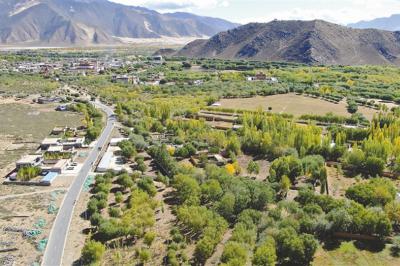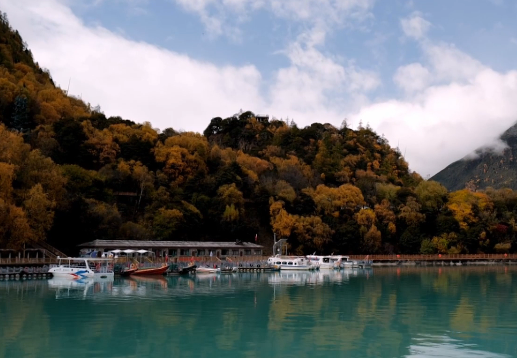 Nov.15,2019 -- Photo shows Palbar painting a piece of Thangka. [China Tibet News/Li Haixia] Inheritance and innovation of "intangible cultural heritage"
Nov.15,2019 -- 55-year-old Tashi, inheritor of Sa'gya Mask which is an intangible cultural heritage, lives in a small village called Sharpa in Sa'gya County of Xigaze City, southwest China's Tibet Autonomous Region. Sa'gya County is located on the south bank of the Yarlung Zangbo River. In 2015, Tashi set up a mask-making company, but the benefits weren't very good. Like many inheritors of intangible cultural heritage, Tashi also encountered the same dilemma -- to stick to tradition or go for innovation. "Masks we made were too traditional to meet modern market demand for a long time. However, if I wanted to support a company, I had to make some changes," he says.
After careful consideration, Tashi decided to innovate on the basis of traditional advantages. In this way, relying on tourism, he made some smaller masks suitable for decoration, which were favored by tourists. More people began to buy new products and the income also doubled several times. "We used to make masks according to orders; now we are able to sell out everything we make," says Tashi with a smile. Today, his company makes an annual net profit of 250,000 yuan RMB.
Good platform for starting up business
Actually, these changes depended on the establishment of the Ethnic Handicraft Industry Entrepreneurship Base in Sa'gya County, which was launched in 2017 with a total investment of nearly 20 million yuan RMB, including exhibition area of handicraft products, production workshops as well as supporting facilities and equipment. It was put into operation in May 2019, mainly including the making of Thangka, mask, silver, bronze ware and other products. At present, 8 inheritors of intangible cultural heritages, such as Thangka, set up Sa'gya Yuanqiao Ethnic Handicraft Industry Entrepreneurship Co., Ltd.. "8 inheritors provide jobs for registered poor households; the total number of people having jobs and participating training reaches about 200," says a person in charge of the base.
Tashi moved the company here at that time. "I used to make masks at home which was crowded," he says, "after moving here, I have more than 300 m2 of house, and enjoy a series of preferential policies government provided; benefits are much better than before."
Like Tashi, Tenzin also moved his Sa'gya Pandita Copper Ware Co., Ltd. into the base. After graduating from junior high school, Tenzin chose an ancient architecture company to learn skills, where he learned sculpture, forging and other skills. Now he becomes a master and has apprentices. "I want more people to inherit this skill. It isn't a skill that can be learned in a short, but young people give up because of low wages just like when I was an apprentice. I understand their difficulties, so they don't have to pay tuition fees and can get 200-300 yuan RMB a day. Besides, I provide food and accommodation for them," says Tenzin. Nowadays, his company's annual income reaches about 3 million yuan RMB.
Thangka painter's experience of getting rich
Palbar owns 3 companies (Thangka, woodworking and sewing) in the park. But his real identity is a Thangka painter. "At first, I established so many companies to subsidize Thangka company," he says. It isn't easy to paint a piece of Thangka. He is responsible for his apprentices' all expenses during this period, which isn't enough to sell his own Thangkas. So he teaches himself woodworking, sewing and other crafts, and works outside to earn money.
In 2018, Thangka company's annual revenue reached over 600,000 yuan RMB. Palbar introduces that there are more and more buyers from cities outside Tibet. However, a painter can only paint one high-end Thangka a year at most, with a market price of nearly 50,000 yuan RMB. An ordinary Thangka takes at least 3 months, with a market price between 4,000 and 5,000 yuan RMB. With the increase of income, many young people offer to learn how to paint Thangka. There are 10 young painters who are all from poor families in his Thangka company now.
"Internet +" promotes entrepreneurship
Time-honored Basiba Tibetan incense is Sa'gya's name card. However, traditional sales model is troubling local craftsmen and young entrepreneurs; Rinchen Ngodrup is one of them. In 2013, Rinchen Ngodrup founded Tibet Sa'gya Kunshi Tibetan Incense Industry and Trade Co., Ltd., and soon solved production land and other problems with the help of the government. "Through the entrepreneurship base, I want to not only realize my dream of starting a business, but also continuously develop and promote our excellent ethnic culture," says Rinchen Ngodrup.
Rinchen Ngodrup wants to let more people know Tibetan incense in his hometown and also help more people to increase their income and become rich. Therefore, he sets up an online store to sell products nationwide through e-commerce platform. Now, he opens 18 offline experience stores outside Tibet, and enriches products to meet various consumers' needs.
|
- Home
- News Tibet |Exclusive |China |World |Other Tibetan-Inhabited Area |Tibet through the Eyes of Foreigners |Related News
- Documents White Papers |Others
- Photo Politics |Economy & Society |Culture & Religion |Human & Nature |Beautiful Tibet |Other Tibetan-Inhabited Area |Exchanges |Related
- Video News |Documentary |Micro-Video |Entertainment
- Art
- Tourism
- In Focus
- About Tibet






